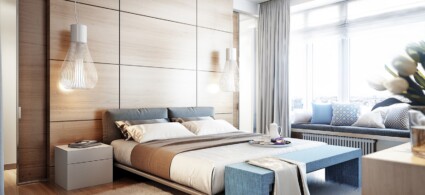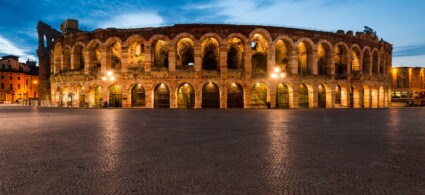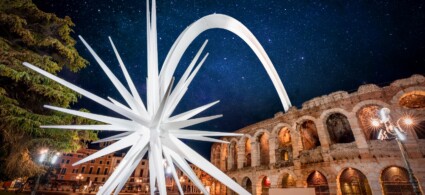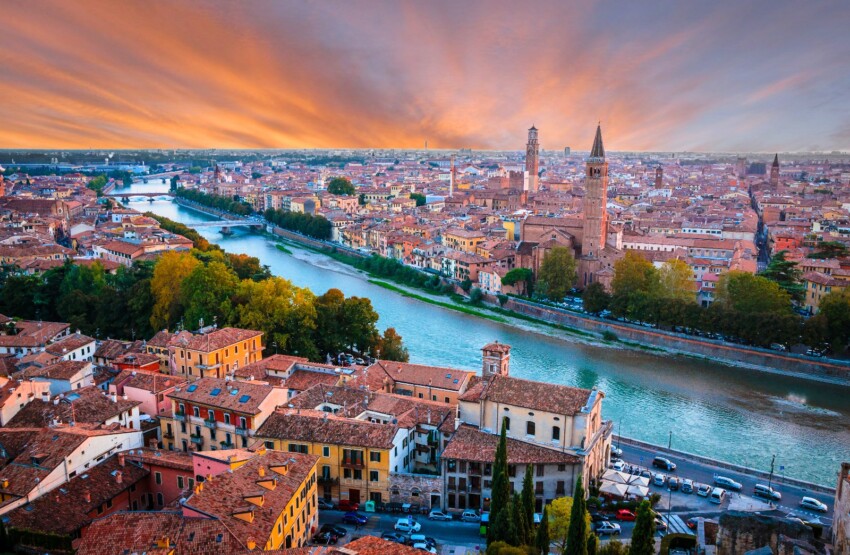

Have you ever considered Verona as a mirror-image destination to Venice? One is the extreme west of the region, the other the extreme east, and ideally the two most visited cities of art in the Veneto are placed on the same line. More or less, it is the line drawn by the high-speed trains that whizz from the lagoon city towards Milan or the busy motorway that crosses the Po Valley.
Like Venice, Verona also boasts a powerful past and a present in which international visitors flock in droves.
End of similarities: Verona’s image is not linked to the waters, although the centre is enclosed within the bend of the river Adige, but to William Shakespeare’s immortal tragedy that tells the story of the two ill-fated lovers Romeo and Juliet and the spectacular sets of the shows staged at the Roman amphitheatre, better known as the Arena di Verona.
This is undoubtedly Verona’s top attraction, a symbolic monument inextricably linked to the city’s image. There is no Arena with a capital A without Verona! An exceptional venue for operas, concerts and major events, the Arena is also a perfect starting point for exploring the city.
You can continue on the trail beaten by most tourists in search of the places of Romeo and Juliet, history’s most famous lovers, or follow themed itineraries dedicated to Roman Verona, medieval Verona, Dante’s Verona, and the Verona of wine.
The amount of things to see in Verona is truly vast. You can visit the city at your leisure during a day trip, but only if you limit yourself to the most famous attractions and if you have no particular interest in museums. If you plan to visit museums and art galleries or want to include the attractions in the surrounding area in your travel plan, it is best to consider staying overnight.
To the attractions linked to the story of Romeo and Juliet, which are invariably the most visited, we devote the next section. Below you will find the must-see attractions in the old town (the oldest part of Verona’s historic centre), the attractions in Veronetta (a lively neighbourhood on the left bank of the Adige) and a couple of other interesting things not far from the centre.

Verona’s number one attraction is undoubtedly the Arena. If the Colosseum did not exist, it would be the most famous Roman amphitheatre in Italy, but it can still boast of being one of the largest preserved Roman amphitheatres. In fact, it is in better condition than the Colosseum, thanks to many restorations over the centuries, and has established itself as the most impressive event venue of the modern age.
Built in the 1st century A.D., in antiquity the Verona Arena hosted the classic gladiator shows and could hold 30,000 spectators. Today, it is the temple of Italian opera: a magnificent open-air stage for spectacular productions featuring up to 150 musicians, 200 chorus artists, 100 dancers and 200 extras in addition to the lead singers, and attended by 15,000 spectators.
The first opera staged at the Arena was Verdi’s Aida, performed in 1913 to mark the centenary of the famous composer’s death. It was a resounding success and since then seeing an opera at the Arena has been the dream of every classical music fan. It is also the best baptism for people with little knowledge of the genre: the atmosphere created during the performances is unequalled elsewhere and is able to involve even the least interested spectators.
It is possible to visit the Veona Arena during the day, if no rehearsals are scheduled.
The Verona Arena is appropriately located in the beautiful Brà Square, one of the three famous squares in the centre of Verona. For many tourists, it is the gateway to the historic city centre and not surprisingly the starting point of many guided tours.
Upon arrival in Bra Square, tourists’ eyes are immediately captured by the majesty of the Arena, but it is also worth taking a look at the other historical buildings and monuments on this beautiful square, from different eras and styles.
Some of the most beautiful include: Barbieri Palace, in neoclassical style, is the seat of the town hall; the Gran Guardia Palace, a monumental building ninety metres long with thirteen magnificent arcades; the Listòn, an elegant paved pavement typical of Venetian cities that serves as the city’s living room.
The other symbolic square of Verona is the central Piazza delle Erbe, the oldest square in the city: it stands on the site of the former Roman forum and is still today the nerve centre of city life.
Here too, the square is bordered by splendid buildings from the medieval and Renaissance periods, including the former Palazzo del Comune, the Casa dei Giudici, the Palazzo Maffei the Casa dei Mercanti and a group of houses with frescoes on the outside known as the Case Mazzanti. The centre of the square is ideally marked by a fountain from Roman times, which the locals have renamed ‘Madonna Verona’.
To get to Piazza delle Erbe from Piazza Brà, take Via Mazzini: this narrow pedestrian street is the shopping street par excellence.
The best-known monument in Piazza delle Erbe is the Lamberti Tower, a red-brick tower that towers 84 metres above all the buildings in the centre of Verona: it is certainly the best vantage point in the city.
It was built in the 12th century at the behest of a wealthy Veronese family later banished from the city. At the end of the 13th century the two bells were added, while the clock was added five centuries later. In the 15th century the tower was damaged by lightning, but was rebuilt and erected with the addition of an elegant octagonal brick and white marble belfry.
The tower is currently open to visitors during daytime hours; in the evenings it is only open for special events.
A visit to the Lamberti Tower is highly recommended because from its top you can enjoy a splendid view of the city. It is possible to purchase a combined ticket for entrance to the tower and the Achille Forti Gallery of Modern Art.
Next to Piazza delle Erbe is Piazza dei Signori, the third stop on the tour of Verona’s squares.
To go from one to the other, one crosses the Arco della Costa, so called because a whale rib hangs from the arch. It has been there for at least four hundred years, which would suggest that Verona is full of dishonest people… but this is just a legend. In fact, it is said that the rib will fall to the ground when an honest and pure-hearted person passes under the arch.
The square is also known as Piazza Dante due to the presence of a statue dedicated to the Supreme Poet.
Buildings worth a look (and a photo!) are the Palazzo della Ragione, the Palazzo del Podestà, the Loggia del Consiglio, the Palazzo di Cansignorio and the Church of Santa Maria Antica.
Continuing the walking tour of the centre of Verona that began in Piazza Brà, we arrive at the Arche Scaligere, the monumental medieval funerary complex a stone’s throw from Piazza dei Signori.
This Gothic-style complex, gathered within an elegant wrought-iron enclosure, includes the tombs of the most important members of the Della Scala or Scaligeri family, the lords of Verona.
Three marble canopied tombs stand out, sumptuously decorated and surmounted by an equestrian statue of the deceased. These are the tombs of Cangrande I, the lord of Verona famous for having hosted Dante Alighieri, Mastino II and Cansignorio. The latter is easily recognisable because it is by far the most sumptuous, richly decorated.
The symbol of medieval Verona is the Scaliger Castle, better known as Castelvecchio. It is the typical castle-fortress built for defensive purposes and characterised by an austere appearance, with walls and crenellated towers: the 42-metre-high Mastio stands out among them.
It was erected in the first half of the 14th century at the behest of Cangrande II della Scala on the remains of an earlier Roman fortress and subsequently enlarged.
Restored in the mid-twentieth century, Castelvecchio today houses the Civic Museum of Verona. Inside you can admire more than 600 works of art from medieval, Renaissance and modern times (up to the 18th century).
Among the many bridges in the centre of Verona, the most famous is the Castelvecchio Bridge (also known as Scaligero Bridge), a magnificent brick and marble bridge with three arches built in the 14th century.
The bridge is an integral part of the castle; originally it provided an escape route in case of enemy attacks. In 1945 it was blown up by the Germans, but reconstruction began in the same year and was completed in 1951.
Just outside the old city, at the tip of the bend formed by the Adige, is the Cathedral of Santa Maria Matricolare.
The cathedral is part of an architectural complex that also includes the baptistery of San Giovanni in Fonte, the church of St. Helen with its archaeological excavations and the canons’ cloister.
The exterior combines Romanesque style with Gothic elements; the interior is more opulent, embellished with valuable works of art.
Another church in Verona worth visiting is the San Zeno Basilica, which can be reached on foot from the centre in about 20 minutes.
The church is named after the African saint who is believed to have converted the Veneto populations to Christianity; his name is linked to numerous local legends and tales of miracles.
It was built at the end of the first millennium on the remains of an earlier early Christian church, already dedicated to San Zeno; it was completed at the end of the 14th century.
Unfortunate is the fate of the Museum of Frescos in Verona: many tourists rush through it to reach its most famous room, the crypt containing Juliet’s tomb.
But why not stop to admire the splendid works in the museum collection? These are magnificent medieval and Renaissance frescoes that originally decorated Veronese palaces and churches.
The Casa Museo Palazzo Maffei is located in the city’s most important Baroque palace, which has been skilfully restored and has become an exhibition venue for an important collection spanning the centuries. Opened in 2020, it presents over 600 works to the public in an unprecedented dialogue between the arts: from Greco-Roman archaeology to Veronese artistic history, from the international avant-garde of the 20th century to contemporary art.
Particularly noteworthy are the masterpieces ranging from Italian Futurism, Metaphysics and Surrealism, as well as abstract painting from the second half of the 20th century: Boccioni, Balla, Severini, Picasso, de Chirico, Morandi and then Magritte, Max Ernst, Picasso, Duchamp, Kandinsky, Warhol through to Fontana, Burri, Manzoni and Vedova, to name but a few of the main artists in the collection.
Those who visit Verona in one day invariably miss it due to lack of time, but if you stay longer be sure to include the romantic Giusti Garden on your list of things to see in Verona.
This is an Italian-style garden created in the 16th century by Agostino Giusti, a descendant of a wealthy family that had moved to the Veneto from Tuscany two centuries earlier. According to the taste of the time, the garden is characterised by elegant symmetries and is embellished with fountains, statues and grottoes.
The garden is located in Veronetta, a historic district to the left of the Adige River where the university’s main campus is located; it can be reached from the city centre on foot, by local buses or the Hop On Hop Off tourist bus.
Besides the Arena, Verona also boasts a splendid Roman Theatre, also used for open-air performances. Older than the Arena (dating back to the 1st century BC), it was built using the natural slope of a hill along the banks of the Adige River.
If the Arena is the sacred place of opera, the Roman theatre is a must-see for Shakespeare fans: in fact, an important festival is held here every year that brings the English playwright’s most famous works to the stage. It is also used for modern theatre, dance and music performances.
The theatre is included in the tour of the Archaeological Museum of Verona: with a single ticket you can see the actual theatre, a model reproducing it as it was in Roman times, and a collection of Roman artefacts found in the Verona area.
It is located in the Veronetta district, about 2 km from Piazza Bra; it can be reached on foot with a nice walk along the river.
Where did Juliet live? How far was her lover’s house? Through which gate did Romeo leave the city of Verona? Relive the most famous love story of all time by visiting the places of Romeo and Juliet in Verona.
They are all located within walking distance of each other and can therefore be easily seen in a day. Juliet’s house is always very crowded, while the other attractions on this themed tour are less visited.
The building known worldwide as Juliet’s House is a medieval tower house that was probably the residence of the Dal Cappello family, the historical Guelph family that inspired the Capulets of Shakespearean tragedy.
Although there is no historical evidence that a Capulet Juliet lived in this house, and the renovation of the house has not been very faithful to historical accuracy, the building is an attraction of international appeal, having become a symbol of eternal love and a pilgrimage destination for all romantic lovers (reciprocated or not).
In 1907, the municipality of Verona bought part of the building, which over time has been turned into a museum to display paintings and frescoes from the medieval period, a collection of prints and engravings depicting the famous love story, and everyday objects from the medieval and Renaissance periods. You can also see the double bed used in the film ‘Romeo and Juliet’ by Franco Zeffirelli and some stage costumes.
The top attraction of Juliet’s house-museum, however, is the famous balcony from which, according to legend, the unfortunate protagonist of the most famous love story of all time looked out. You too can feel like Juliet for a day by climbing to the top of the stairs and looking out onto the balcony, but be prepared for a long queue because many other people want to try this unique experience!
If you are not interested in visiting the museum or looking out from the balcony, you can enter the courtyard of the house for free and photograph the balcony from below. At one time the walls leading into the courtyard were covered with graffiti with the names of lovers who had visited the house; today writing on the walls is forbidden.
In the courtyard of Juliet’s House there is a very famous bronze statue with the maiden’s likeness. It is actually a copy of the famous statue made by the Veronese artist Nereo Costantini on behalf of the municipality of Verona in 1968.
The idea of placing a statue was suggested by Shakespeare himself, who in Act 5 of the tragedy makes the dead girl’s father say these words: ‘I will raise a statue all of gold to Juliet; and as long as the city of Verona endures, no other image shall be so honoured as that of pure and faithful Juliet’.
One could say that these were prophetic words. For years and years, tourists flocked to see the famous statue, which soon became associated with a superstitious ritual: the rumour spread that touching Juliet’s breast brought good luck in love.
Lots of groping had a negative effect on the statue’s health, so in 2014 it was replaced by the copy.
The original statue was moved to the inner atrium of the house-museum, where tourists can still admire it without touching it. From the colour of the two breasts, you can easily recognise the one that was habitually touched by tourists; the ultimate proof is the small hole left at the level of the propitiatory breast.
Romeo also had his house in Verona, but the latter is much less famous than that of his beloved. It is located a short distance from Juliet’s House, in the same street as the Arche Scaligere, and is a historic building that was the home of the Monticoli, the Ghibelline family that became the Montagues in Shakespeare’s tragedy.
The Romeo’s House is a typical medieval house, large in size; the side facing the street is sheltered by a high crenellated wall, which leaves little to imagine of what lies within.
The building is now largely privately owned and therefore cannot be visited; one wing of the building, however, houses a typical osteria serving traditional Veneto cuisine. You can enjoy a good dinner while imagining young Romeo fortuitously leaving the palace to meet his beloved Juliet.
The entrance to Brà Square is on the south side through a majestic arched gateway built in the 14th century and known as the Portoni della Brà. Originally the gateway was intended to serve as a link between Castelvecchio and a fortified citadel of which only a few remains of walls near Piazza Cittadella remain today.
A famous quote from ‘Romeo and Juliet’ can be read on the gate. These are the words uttered by Romeo as he leaves for exile to Mantua: “There is no world outside the walls of Verona: but only purgatory, torture, hell; he who is banished from here, is banished from the world; and exile from the world is death.”
This would therefore be the place where Romeo bid farewell to his hometown before his exile.
An ideal tour of Verona’s Romeo and Juliet-themed attractions can only end at the place symbolic of the epilogue of this sad love story, namely Juliet’s tomb.
Don’t expect anything triumphal or glitzy: the tomb of the Shakespearean heroine is a humble red marble sarcophagus placed in the centre of a small underground crypt in a deconsecrated monastery.
Numerous legends and rituals due to superstition are linked to this sarcophagus, which over the centuries caused the removal of small marble fragments by history enthusiasts and the curious. It is said that some of these fragments became a pair of earrings and a necklace worn by the French Empress Marie-Louise of Habsburg-Lorraine.
The monastery where the sarcophagus is kept is the Convent of San Francesco al Corso, located about 1 km from the centre in an area that was outside the city walls at the time of Romeo and Juliet’s adventures. This explains why Romeo could reach it even though he was banned from the city of Verona.
It is only possible to see Juliet’s tomb by purchasing a ticket to the Museo degli Affreschi Giovanni Battista Cavalcaselle.
In the following map you can see the location of the main places of interest mentioned in this article.
Sleeping in the centre of Verona is the best choice for those who want romance and for those travelling by public transport.
Hotels and B&Bs in the centre of Verona are housed in elegant historical buildings; the most beautiful rooms have balconies with panoramic views over the city. If you dream of a completely relaxing stay or want to celebrate an important occasion, choose a luxury hotel with spa.
In the trade fair area and near the motorway exits, there is a wide choice of business hotels, almost always belonging to major international chains.
They are decidedly less attractive but do not discard them a priori: they are very convenient to reach if you are travelling by car, guarantee high quality standards and often on dates when no trade fair events are scheduled offer very attractive discounted rates.
Reaching Verona by car is really easy: the city is located along the A4, the motorway that crosses the entire Po Valley connecting Turin (to the west) to Trieste (to the east); those coming from the north or south can take the A4 from the A22 Brennero-Modena. The recommended exit for those wishing to visit the city is Verona Sud.
Be careful once you arrive: the historic centre is a restricted traffic zone and free parking spaces are practically non-existent. It is recommended to leave your car outside the centre.
For those who want to reach Verona by public transport, the train is an excellent solution. The city is located along the Venice-Milan railway line: it is one of the most important in Italy and is served by frequent trains (regional, intercity and high-speed). The Verona Porta Nuova railway station is about 2 km from the city centre and can be reached on foot or by bus.
Getting to Verona by bus is also easy, both from neighbouring cities and from the most important locations in the Veneto region. Long-distance buses also connect Verona with numerous national and international destinations.
Verona has an airport, located only 13 km from the city centre and served by low-cost flights; from the airport it is possible to reach the centre by shuttle bus. Another easy airport to reach is Brescia airport, about 50 km away.
What's the weather at Verona? Below are the temperatures and the weather forecast at Verona for the next few days.
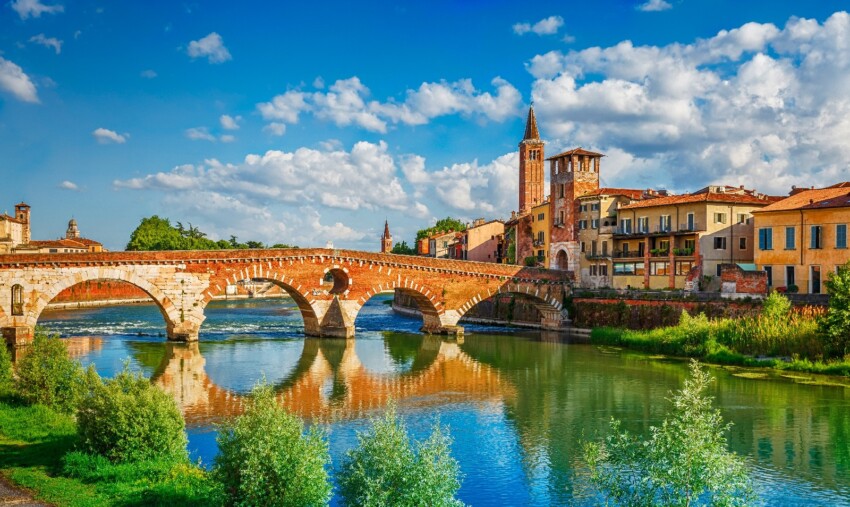
The province of Verona includes all the resorts along the Veneto shore of Lake Garda. Of these, the most famous are Peschiera del Garda, a magnificent walled city with a particular star shape, the very romantic Bardolino, and Lazise, a place suitable for various types of holiday.
The last town in the Veneto region of Lake Garda before entering Trentino-Alto Adige is Malcesine, perfect for those who love trekking and mountain biking. A cable car departs from the centre and takes you to the top of Monte Baldo: from here you can enjoy a magnificent view of the entire lake and set off on exciting adventures on foot or in the saddle.
The province of Verona is one of the largest wine producers in Italy, making it an ideal destination for wine and food tourism. Your wine tour of the province of Verona cannot miss the enchanting medieval town of Soave, famous for its impressive castle and famous wine.
If you are travelling with your children, include in your holiday programme a trip to Gardaland: Italy’s most famous amusement park is located a couple of kilometres from Lazise.
The province of Verona represents the western tip of the Veneto; the capital city is located in the centre of the province. It is approximately 120 km from Venice (to the east) and 160 km from Milan (to the west).
City Card allow you to save on public transport and / or on the entrances to the main tourist attractions.

